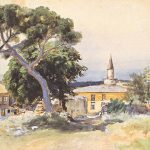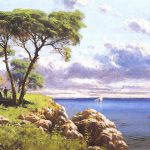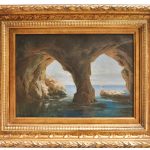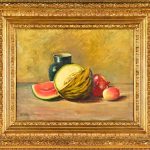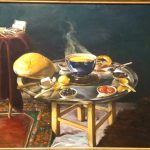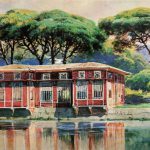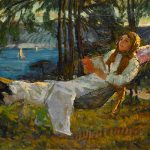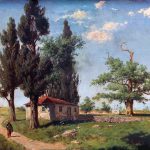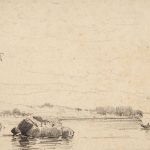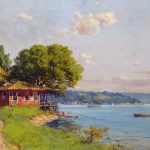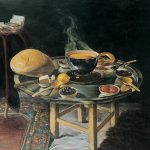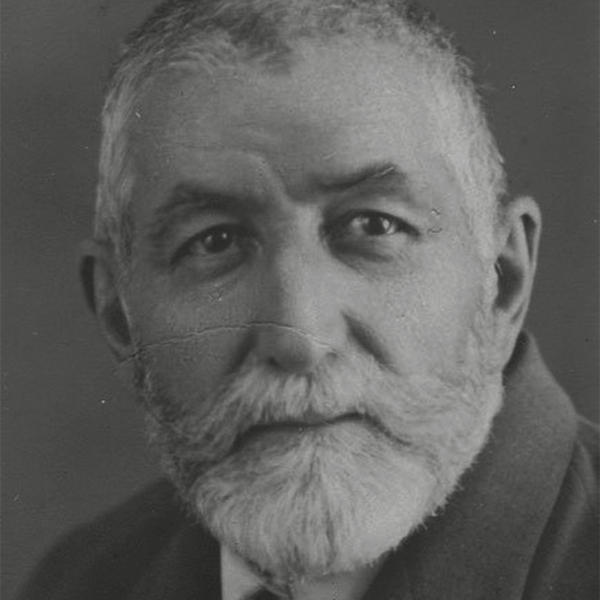
Who is Hoca Ali Rıza?
Known for his paintings of landscapes, still lifes and dreams, Hoca Ali Rıza completed his education at the Military Academy and took painting lessons from Süleyman Seyyid and Monsieur Kess. Due to his achievements while he was a student in Harbiye, he was awarded the title of II. She was awarded with an order by Abdulhamid. When he graduated in 1885/1886, he was going to be sent to Italy for education, but he could not use this opportunity due to a cholera epidemic in Naples. In 1886, he was appointed as Osman Nuri Pasha’s assistant at Kuleli High School and remained in this position until 1908.
The painter continued his relationship and friendship with his teacher Süleyman Seyyid for 29 years. In 1891, he participated in photographic documentation of the first capitals of the Ottoman Empire and drew views of Turkish-Islamic works. Hoca Ali Rıza, who painted porcelain together with artists such as Halid Naci, Şeker Ahmed Pasha, Osman Nuri Pasha, Ömer Adil Bey, in the Yıldız Porcelain Factory painting workshop in 1895, was commissioned by II. Within the scope of Abdulhamid’s project to establish a military museum similar to those in Europe (Türk Esliha-i Antika Museum), he served in the commission consisting of Zonaro, Hoca Ali Rıza, Katip Hüsnü Tengüz, Topçu Sami and Ahmed Ziya Akbulut, chaired by Mahmud Şevket Pasha. He worked with Zonaro, whom he met here, in Değirmendere, and made compositions about the Greek-Turkish War. In 1903, she participated in the preparation of an album containing old Ottoman clothes, again under the direction of Mahmud Şevket Pasha.
He joined the Harbiye Printing House in 1909 and worked as the head painter for two years. He served as president of the Ottoman Painters Society between 1909 and 1912. In 1909, he organized a painting exhibition at Üsküdar İskele Gazinosu. Hoca Ali Rıza, who taught in the Prince's classes in 1910, retired as lieutenant colonel in 1911. After his retirement, he taught landscape at İnas Sanayi-i Nefise Mektebi in 1914, in 1918 at Çamlıca İnas Girls' School, in 1921 at Üsküdar Girls' Industry-i Mektebi, and in 1929 at Sultan Ahmed Boys' Practical Life School. He worked as an art teacher at. She participated in Galatasaray Exhibitions, Community Center Exhibitions, and the 1928 Paris Exhibition.
He said that he aims to reflect his hometown in the best way in terms of emotion, form and morality, “My only pleasure and feelings are not to kill the nests of my country, the views of the neighborhoods, the trees, the high historical monuments that speak a local and national language of life sprinkled in the emerald perspective under the sweet sky and to give them a long life.” .” These words of Hoca Ali Rıza show the connection between his understanding of painting and the Barbizon School.
According to him, Hodja Ali Rıza, whom Nurullah Berk likens to the Turkish Corot, never introduced himself as the leader of a new view and did not want to be influenced by it. The landscapes of Hoca Ali Rıza, who aims to represent nature rather than copying it and defines his profession as a landscape painter, create a bright, happy feeling of nature. He is the first Turkish painter among his contemporaries to open up to nature, to work in nature, to reflect nature through the filter of his own eyes, in other words, to literally create landscapes.
His paintings, which he created with charcoal, watercolour, pastel and oil, are located in Üsküdar and its surroundings, Ahmediye, Toygartepesi, Tunusbağı, Şemsipaşa, Haydarpaşa, İbrahimağa, Paşabahçesi, Karacaahmet, Çamlıca, Kayışdağı, Bebek, Arnavutköy, Bosphorus shores, waterside mansions, old streets, coffee houses. , street vendors, women, houses, Istanbul views, hills, trees, rocks, meadows, streams, sea, and sky are among the subjects he paints.
